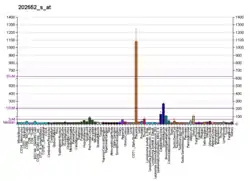| CRIM1 | |||||||||||||||||||||||||||||||||||||||||||||||||||
|---|---|---|---|---|---|---|---|---|---|---|---|---|---|---|---|---|---|---|---|---|---|---|---|---|---|---|---|---|---|---|---|---|---|---|---|---|---|---|---|---|---|---|---|---|---|---|---|---|---|---|---|
| Identifiers | |||||||||||||||||||||||||||||||||||||||||||||||||||
| Aliases | CRIM1, CRIM-1, S52, cysteine rich transmembrane BMP regulator 1 (chordin-like), cysteine rich transmembrane BMP regulator 1 | ||||||||||||||||||||||||||||||||||||||||||||||||||
| External IDs | OMIM: 606189 MGI: 1354756 HomoloGene: 9510 GeneCards: CRIM1 | ||||||||||||||||||||||||||||||||||||||||||||||||||
| |||||||||||||||||||||||||||||||||||||||||||||||||||
| |||||||||||||||||||||||||||||||||||||||||||||||||||
| |||||||||||||||||||||||||||||||||||||||||||||||||||
| |||||||||||||||||||||||||||||||||||||||||||||||||||
| |||||||||||||||||||||||||||||||||||||||||||||||||||
| Wikidata | |||||||||||||||||||||||||||||||||||||||||||||||||||
| |||||||||||||||||||||||||||||||||||||||||||||||||||
Cysteine-rich motor neuron 1 protein is a protein that in humans is encoded by the CRIM1 gene.[5][6]
Function
Motor neurons are among the earliest neurons to appear after the commencement of cell patterning and the beginning of cell differentiation. Differentiation occurs in a ventral-to-dorsal gradient and is mediated, at least in part, by the concentration of ventrally expressed sonic hedgehog protein (SHH; MIM 600725). Dorsally expressed factors, such as members of the bone morphogenic protein (e.g., BMP4; MIM 112262) and transforming growth factor-beta (e.g., TGFB1; MIM 190180) families, can repress the induction of these neurons. CRIM1 may interact with growth factors implicated in motor neuron differentiation and survival.[5][6]
Clinical significance
Loss of Crim1 function as demonstrated by the Crim1 KST264 hypomorph mice resulted in onset of chronic kidney disease with accompanying pathology including papillary hypoplasia, functional urinary tract obstruction, ectopic collagen accumulation within the endothelium and tubulointerstitial fibrosis which was in part attributed by (endothelial) epithelial–mesenchymal transition.[7][8]
References
- 1 2 3 ENSG00000150938 GRCh38: Ensembl release 89: ENSG00000277354, ENSG00000150938 - Ensembl, May 2017
- 1 2 3 GRCm38: Ensembl release 89: ENSMUSG00000024074 - Ensembl, May 2017
- ↑ "Human PubMed Reference:". National Center for Biotechnology Information, U.S. National Library of Medicine.
- ↑ "Mouse PubMed Reference:". National Center for Biotechnology Information, U.S. National Library of Medicine.
- 1 2 Kolle G, Georgas K, Holmes GP, Little MH, Yamada T (Feb 2000). "CRIM1, a novel gene encoding a cysteine-rich repeat protein, is developmentally regulated and implicated in vertebrate CNS development and organogenesis". Mechanisms of Development. 90 (2): 181–93. doi:10.1016/S0925-4773(99)00248-8. PMID 10642437. S2CID 6529349.
- 1 2 "Entrez Gene: CRIM1 cysteine rich transmembrane BMP regulator 1 (chordin-like)".
- ↑ Phua YL, Martel N, Pennisi DJ, Little MH, Wilkinson L (Apr 2013). "Distinct sites of renal fibrosis in Crim1 mutant mice arise from multiple cellular origins". The Journal of Pathology. 229 (5): 685–96. doi:10.1002/path.4155. PMID 23224993. S2CID 22837861.
- ↑ Wilkinson L, Kurniawan ND, Phua YL, Nguyen MJ, Li J, Galloway GJ, Hashitani H, Lang RJ, Little MH (Aug 2012). "Association between congenital defects in papillary outgrowth and functional obstruction in Crim1 mutant mice" (PDF). The Journal of Pathology. 227 (4): 499–510. doi:10.1002/path.4036. PMID 22488641. S2CID 2777257.
External links
- Human CRIM1 genome location and CRIM1 gene details page in the UCSC Genome Browser.
Further reading
- Wilkinson L, Kurniawan ND, Phua YL, Nguyen MJ, Li J, Galloway GJ, Hashitani H, Lang RJ, Little MH (Aug 2012). "Association between congenital defects in papillary outgrowth and functional obstruction in Crim1 mutant mice" (PDF). The Journal of Pathology. 227 (4): 499–510. doi:10.1002/path.4036. PMID 22488641. S2CID 2777257.
- Phua YL, Martel N, Pennisi DJ, Little MH, Wilkinson L (Apr 2013). "Distinct sites of renal fibrosis in Crim1 mutant mice arise from multiple cellular origins". The Journal of Pathology. 229 (5): 685–96. doi:10.1002/path.4155. PMID 23224993. S2CID 22837861.
- Pennisi DJ, Wilkinson L, Kolle G, Sohaskey ML, Gillinder K, Piper MJ, McAvoy JW, Lovicu FJ, Little MH (Feb 2007). "Crim1KST264/KST264 mice display a disruption of the Crim1 gene resulting in perinatal lethality with defects in multiple organ systems". Developmental Dynamics. 236 (2): 502–11. doi:10.1002/dvdy.21015. PMID 17106887. S2CID 1563138.
- Zhang Z, Henzel WJ (Oct 2004). "Signal peptide prediction based on analysis of experimentally verified cleavage sites". Protein Science. 13 (10): 2819–24. doi:10.1110/ps.04682504. PMC 2286551. PMID 15340161.
- Wilkinson L, Kolle G, Wen D, Piper M, Scott J, Little M (Sep 2003). "CRIM1 regulates the rate of processing and delivery of bone morphogenetic proteins to the cell surface". The Journal of Biological Chemistry. 278 (36): 34181–8. doi:10.1074/jbc.M301247200. PMID 12805376.
- Glienke J, Sturz A, Menrad A, Thierauch KH (Dec 2002). "CRIM1 is involved in endothelial cell capillary formation in vitro and is expressed in blood vessels in vivo". Mechanisms of Development. 119 (2): 165–75. doi:10.1016/S0925-4773(02)00355-6. PMID 12464430. S2CID 7308653.
- Georgas K, Bowles J, Yamada T, Koopman P, Little MH (Dec 2000). "Characterisation of Crim1 expression in the developing mouse urogenital tract reveals a sexually dimorphic gonadal expression pattern". Developmental Dynamics. 219 (4): 582–7. doi:10.1002/1097-0177(2000)9999:9999<::AID-DVDY1072>3.0.CO;2-I. PMID 11084657.





